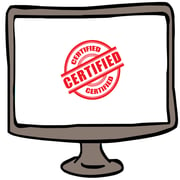Optometry EHR: The Importance of System Workflow and Certification
Last week, Ian Lane shared with us the differences between stage 1 and stage 2 of meaningful use. And this week he is back to talk about the importantce of your system's workflow and certification when it comes to optometry EHR.
Ian's Insights: The Importance of Your Optometry EHR Workflow

We have spent a great deal of time discussing the differences between 2011 and 2014 EHR certification. In the previous blog we learned that all 2011 Certified EHRs will expire and all have to be recertified to the more complex 2014 requirements. This means that even those doctors who have already attested to stage 1 of meaningful use will have to either upgrade to the 2014 version of their current EHR, which also means retraining on the new version, or switch to another 2014 Certified EHR. Either way, there will be a learning curve. This raises the subject of "Meaningful Usefullness."
It's important to understand that although all EHRs must go through a standardized certification testing routine, this doesn't provide you with real guidance on usability of the system. This means it's up to you to do the due diligence on usability and workflow.
 It's one thing for an EHR vendor to attain 2014 certification, and an entirely different situation for a practice trying to use that Certified EHR to enter patient data and generate reports for attestation. Since you have to upgrade to a new 2014 Certified EHR anyway, now would be a good time to ask the EHR vendor for a demo of the 2014 Certified version and to keep a watchful eye out for how easy it will be to comply with the attestation requirements for doctors and staff during the meaningful use reporting period.
It's one thing for an EHR vendor to attain 2014 certification, and an entirely different situation for a practice trying to use that Certified EHR to enter patient data and generate reports for attestation. Since you have to upgrade to a new 2014 Certified EHR anyway, now would be a good time to ask the EHR vendor for a demo of the 2014 Certified version and to keep a watchful eye out for how easy it will be to comply with the attestation requirements for doctors and staff during the meaningful use reporting period.
Workflow is the EHR vendor term for what you have to do as a user to get your job done. And "Meaningful Usefullness" is your office. So what's the take home question for you as the user? How easy is it for you to continue seeing patients efficiently while using your EHR?
Read the advice of other ODs on how they improve their practices in our ebook below.

